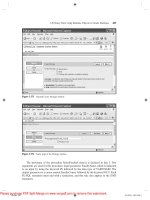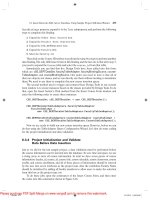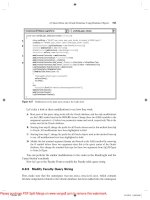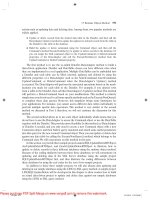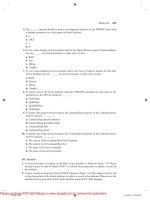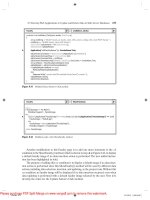Practical c++ programmin
Bạn đang xem bản rút gọn của tài liệu. Xem và tải ngay bản đầy đủ của tài liệu tại đây (2.77 MB, 665 trang )
This document is created with a trial version of CHM2PDF Pilot
I l@ve RuBoard
•
•
•
•
•
•
Table of Contents
Index
Reviews
Examples
Reader Reviews
Errata
Practical C++ Programming
By Steve Oualline
Publisher
Pub Date
ISBN
Pages
: O'Reilly
: December 2002
: 0-596-00419-2
: 574
In short, to-the-point chapters, Practical C++ Programming covers all aspects of programming
including style, software engineering, programming design, object-oriented design, and debugging. It
also covers common mistakes and how to find (and avoid) them. End of chapter exercises help you
ensure you've mastered the material. Steve Oualline's clear, easy-going writing style and hands-on
approach to learning make Practical C++ Programming a nearly painless way to master this complex
but powerful programming language.
I l@ve RuBoard
This document is created with a trial version of CHM2PDF Pilot
I l@ve RuBoard
•
•
•
•
•
•
Table of Contents
Index
Reviews
Examples
Reader Reviews
Errata
Practical C++ Programming
By Steve Oualline
Publisher
Pub Date
ISBN
Pages
: O'Reilly
: December 2002
: 0-596-00419-2
: 574
Copyright
Preface
Scope of This Handbook
How This Book Is Organized
How to Read This Book If You Already Know C
Font Conventions
How to Contact Us
Acknowledgments for the First Edition
Acknowledgments for the Second Edition
Part I: The Basics
Chapter 1. What Is C++?
Section 1.1. A Brief History of C++
Section 1.2. C++ Organization
Section 1.3. How to Learn C++
Chapter 2. The Basics of Program Writing
Section 2.1. Programs from Conception to Execution
Section 2.2. Creating a Real Program
Section 2.3. Getting Help in Unix
Section 2.4. Getting Help in an IDE
Section 2.5. Programming Exercises
Chapter 3. Style
This document is created with a trial version of CHM2PDF Pilot
Section 3.1. Comments
Section 3.2. C++ Code
Section 3.3. Naming Style
Section 3.4. Coding Religion
Section 3.5. Indentation and Code Format
Section 3.6. Clarity
Section 3.7. Simplicity
Section 3.8. Consistency and Organization
Section 3.9. Further Reading
Section 3.10. Summary
Chapter 4. Basic Declarations and Expressions
Section 4.1. Basic Program Structure
Section 4.2. Simple Expressions
Section 4.3. The std::cout Output Object
Section 4.4. Variables and Storage
Section 4.5. Variable Declarations
Section 4.6. Integers
Section 4.7. Assignment Statements
Section 4.8. Floating-Point Numbers
Section 4.9. Floating-Point Divide Versus Integer Divide
Section 4.10. Characters
Section 4.11. Wide Characters
Section 4.12. Boolean Type
Section 4.13. Programming Exercises
Section 4.14. Answers to Chapter Questions
Chapter 5. Arrays, Qualifiers, and Reading Numbers
Section 5.1. Arrays
Section 5.2. Strings
Section 5.3. Reading Data
Section 5.4. Initializing Variables
Section 5.5. Multidimensional Arrays
Section 5.6. C-Style Strings
Section 5.7. Types of Integers
Section 5.8. Types of Floats
Section 5.9. Constant and Reference Declarations
Section 5.10. Qualifiers
Section 5.11. Hexadecimal and Octal Constants
Section 5.12. Operators for Performing Shortcuts
Section 5.13. Side Effects
Section 5.14. Programming Exercises
Section 5.15. Answers to Chapter Questions
Chapter 6. Decision and Control Statements
Section 6.1. if Statement
Section 6.2. else Statement
Section 6.3. How Not to Use std::strcmp
Section 6.4. Looping Statements
Section 6.5. while Statement
Section 6.6. break Statement
Section 6.7. continue Statement
Section 6.8. The Assignment Anywhere Side Effect
This document is created with a trial version of CHM2PDF Pilot
Section 6.9. Programming Exercises
Section 6.10. Answers to Chapter Questions
Chapter 7. The Programming Process
Section 7.1. Setting Up Your Work Area
Section 7.2. The Specification
Section 7.3. Code Design
Section 7.4. The Prototype
Section 7.5. The Makefile
Section 7.6. Testing
Section 7.7. Debugging
Section 7.8. Maintenance
Section 7.9. Revisions
Section 7.10. Electronic Archaeology
Section 7.11. Mark Up the Program
Section 7.12. Use the Debugger
Section 7.13. Use the Text Editor as a Browser
Section 7.14. Add Comments
Section 7.15. Programming Exercises
Part II: Simple Programming
Chapter 8. More Control Statements
Section 8.1. for Statement
Section 8.2. switch Statement
Section 8.3. switch, break, and continue
Section 8.4. Programming Exercises
Section 8.5. Answers to Chapter Questions
Chapter 9. Variable Scope and Functions
Section 9.1. Scope and Storage Class
Section 9.2. Namespaces
Section 9.3. Functions
Section 9.4. Summary of Parameter Types
Section 9.5. Recursion
Section 9.6. Structured Programming Basics
Section 9.7. Real-World Programming
Section 9.8. Programming Exercises
Section 9.9. Answers to Chapter Questions
Chapter 10. The C++ Preprocessor
Section 10.1. #define Statement
Section 10.2. Conditional Compilation
Section 10.3. #include Files
Section 10.4. Parameterized Macros
Section 10.5. Advanced Features
Section 10.6. Summary
Section 10.7. Programming Exercises
Section 10.8. Answers to Chapter Questions
Chapter 11. Bit Operations
Section 11.1. Bit Operators
Section 11.2. The AND Operator (&)
Section 11.3. Bitwise OR (|)
This document is created with a trial version of CHM2PDF Pilot
Section 11.3. Bitwise OR (|)
Section 11.4. The Bitwise Exclusive OR (^)
Section 11.5. The Ones Complement Operator (NOT) (~)
Section 11.6. The Left and Right Shift Operators (<<, >>)
Section 11.7. Setting, Clearing, and Testing Bits
Section 11.8. Bitmapped Graphics
Section 11.9. Programming Exercises
Section 11.10. Answers to Chapter Questions
Part III: Advanced Types and Classes
Chapter 12. Advanced Types
Section 12.1. Structures
Section 12.2. Unions
Section 12.3. typedef
Section 12.4. enum Type
Section 12.5. Bit Members or Packed Structures
Section 12.6. Arrays of Structures
Section 12.7. Programming Exercises
Section 12.8. Answers to Chapter Questions
Chapter 13. Simple Classes
Section 13.1. Stacks
Section 13.2. Improved Stack
Section 13.3. Using a Class
Section 13.4. Introduction to Constructors and Destructors
Section 13.5. Automatically Generated Member Functions
Section 13.6. Shortcuts
Section 13.7. Style
Section 13.8. Structures Versus Classes
Section 13.9. Programming Exercises
Chapter 14. More on Classes
Section 14.1. Friends
Section 14.2. Constant Functions
Section 14.3. Constant Members
Section 14.4. Static Member Variables
Section 14.5. Static Member Functions
Section 14.6. The Meaning of static
Section 14.7. Programming Exercises
Chapter 15. Simple Pointers
Section 15.1. const Pointers
Section 15.2. Pointers and Printing
Section 15.3. Pointers and Arrays
Section 15.4. The reinterpret_cast
Section 15.5. Pointers and Structures
Section 15.6. Command-Line Arguments
Section 15.7. Programming Exercises
Section 15.8. Answers to Chapter Questions
Part IV: Advanced Programming Concepts
Chapter 16. File Input/Output
Section 16.1. C++ File I/O
This document is created with a trial version of CHM2PDF Pilot
Section 16.1. C++ File I/O
Section 16.2. Conversion Routines
Section 16.3. Binary and ASCII Files
Section 16.4. The End-of-Line Puzzle
Section 16.5. Binary I/O
Section 16.6. Buffering Problems
Section 16.7. Unbuffered I/O
Section 16.8. Designing File Formats
Section 16.9. C-Style I/O Routines
Section 16.10. C-Style Conversion Routines
Section 16.11. C-Style Binary I/O
Section 16.12. C- Versus C++- Style I/O
Section 16.13. Programming Exercises
Section 16.14. Answers to Chapter Questions
Chapter 17. Debugging and Optimization
Section 17.1. Code Reviews
Section 17.2. Serial Debugging
Section 17.3. Going Through the Output
Section 17.4. Interactive Debuggers
Section 17.5. Debugging a Binary Search
Section 17.6. Interactive Debugging Tips and Tricks
Section 17.7. Runtime Errors
Section 17.8. Optimization
Section 17.9. How to Optimize
Section 17.10. Case Study: Inline Functions Versus Normal Functions
Section 17.11. Case Study: Optimizing a Color-Rendering Algorithm
Section 17.12. Programming Exercises
Section 17.13. Answers to Chapter Questions
Chapter 18. Operator Overloading
Section 18.1. Creating a Simple Fixed-Point Class
Section 18.2. Operator Functions
Section 18.3. Operator Member Functions
Section 18.4. Warts
Section 18.5. Full Definition of the Fixed-Point Class
Section 18.6. Programming Exercises
Section 18.7. Answers to Chapter Questions
Chapter 19. Floating Point
Section 19.1. Floating-Point Format
Section 19.2. Floating Addition/Subtraction
Section 19.3. Multiplication and Division
Section 19.4. Overflow and Underflow
Section 19.5. Roundoff Error
Section 19.6. Accuracy
Section 19.7. Minimizing Roundoff Error
Section 19.8. Determining Accuracy
Section 19.9. Precision and Speed
Section 19.10. Power Series
Section 19.11. Programming Exercises
Chapter 20. Advanced Pointers
Section 20.1. Pointers, Structures, and Classes
This document is created with a trial version of CHM2PDF Pilot
Section 20.2. delete Operator
Section 20.3. Linked Lists
Section 20.4. Ordered Linked Lists
Section 20.5. Doubly Linked Lists
Section 20.6. Trees
Section 20.7. Printing a Tree
Section 20.8. The Rest of the Program
Section 20.9. Data Structures for a Chess Program
Section 20.10. Programming Exercises
Section 20.11. Answers to Chapter Questions
Chapter 21. Advanced Classes
Section 21.1. Derived Classes
Section 21.2. Virtual Functions
Section 21.3. Virtual Classes
Section 21.4. Function Hiding in Derived Classes
Section 21.5. Constructors and Destructors in Derived Classes
Section 21.6. The dynamic_cast Operator
Section 21.7. Summary
Section 21.8. Programming Exercises
Section 21.9. Answers to Chapter Questions
Part V: Other Language Features
Chapter 22. Exceptions
Section 22.1. Adding Exceptions to the Stack Class
Section 22.2. Exceptions Versus assert
Section 22.3. Programming Exercises
Chapter 23. Modular Programming
Section 23.1. Modules
Section 23.2. Public and Private
Section 23.3. The extern Storage Class
Section 23.4. Headers
Section 23.5. The Body of the Module
Section 23.6. A Program to Use Infinite Arrays
Section 23.7. The Makefile for Multiple Files
Section 23.8. Using the Infinite Array
Section 23.9. Dividing a Task into Modules
Section 23.10. Module Design Guidelines
Section 23.11. Programming Exercises
Chapter 24. Templates
Section 24.1. What Is a Template?
Section 24.2. Templates: The Hard Way
Section 24.3. Templates: The C++ Way
Section 24.4. Function Specialization
Section 24.5. Class Templates
Section 24.6. Class Specialization
Section 24.7. Implementation Details
Section 24.8. Advanced Features
Section 24.9. Summary
Section 24.10. Programming Exercises
This document is created with a trial version of CHM2PDF Pilot
Chapter 25. Standard Template Library
Section 25.1. STL Basics
Section 25.2. Class List—A Set of Students
Section 25.3. Creating a Waiting List with the STL List
Section 25.4. Storing Grades in a STL Map
Section 25.5. Putting It All Together
Section 25.6. Practical Considerations When Using the STL
Section 25.7. Getting More Information
Section 25.8. Exercises
Chapter 26. Program Design
Section 26.1. Design Goals
Section 26.2. Design Factors
Section 26.3. Design Principles
Section 26.4. Coding
Section 26.5. Objects
Section 26.6. Real-World Design Techniques
Section 26.7. Conclusion
Chapter 27. Putting It All Together
Section 27.1. Requirements
Section 27.2. Code Design
Section 27.3. Coding
Section 27.4. Functional Description
Section 27.5. Testing
Section 27.6. Revisions
Section 27.7. A Final Warning
Section 27.8. Program Files
Section 27.9. Programming Exercises
Chapter 28. From C to C++
Section 28.1. K&R-Style Functions
Section 28.2. struct
Section 28.3. malloc and free
Section 28.4. Turning Structures into Classes
Section 28.5. setjmp and longjmp
Section 28.6. Mixing C and C++ Code
Section 28.7. Summary
Section 28.8. Programming Exercise
Chapter 29. C++'s Dustier Corners
Section 29.1. do/while
Section 29.2. goto
Section 29.3. The ?: Construct
Section 29.4. The Comma Operator
Section 29.5. Overloading the ( ) Operator
Section 29.6. Pointers to Members
Section 29.7. The asm Statement
Section 29.8. The mutable Qualifier
Section 29.9. Run Time Type Identification
Section 29.10. Trigraphs
Section 29.11. Answers to Chapter Questions
This document is created with a trial version of CHM2PDF Pilot
Chapter 30. Programming Adages
Section 30.1. General
Section 30.2. Design
Section 30.3. Declarations
Section 30.4. switch Statement
Section 30.5. Preprocessor
Section 30.6. Style
Section 30.7. Compiling
Section 30.8. The Ten Commandments for C++ Programmers
Section 30.9. Final Note
Section 30.10. Answers to Chapter Questions
Part VI: Appendixes
Appendix A. ASCII Table
Appendix B. Ranges
Appendix C. Operator Precedence Rules
Section C.1. Standard Rules
Section C.2. Practical Subset of the Operator Precedence Rules
Appendix D. Computing Sine Using a Power Series
Appendix E. Resources
Section E.1. Compilers
Section E.2. Standard Template Library
Section E.3. Standards
Section E.4. Programming Tools
Colophon
Index
I l@ve RuBoard
This document is created with a trial version of CHM2PDF Pilot
I l@ve RuBoard
Copyright
Copyright © 2003, 1995 O'Reilly & Associates, Inc.
Printed in the United States of America.
Published by O'Reilly & Associates, Inc., 1005 Gravenstein Highway North, Sebastopol, CA 95472.
O'Reilly & Associates books may be purchased for educational, business, or sales promotional use.
Online editions are also available for most titles (). For more information,
contact our corporate/institutional sales department: (800) 998-9938 or
Nutshell Handbook, the Nutshell Handbook logo, and the O'Reilly logo are registered trademarks of
O'Reilly & Associates, Inc. Many of the designations used by manufacturers and sellers to distinguish
their products are claimed as trademarks. Where those designations appear in this book, and O'Reilly
& Associates, Inc. was aware of a trademark claim, the designations have been printed in caps or
initial caps. The association between the image of an Eastern chipmunk and the topic of C++
programming is a trademark of O'Reilly & Associates, Inc.
While every precaution has been taken in the preparation of this book, the publisher and authors
assume no responsibility for errors or omissions, or for damages resulting from the use of the
information contained herein.
I l@ve RuBoard
This document is created with a trial version of CHM2PDF Pilot
I l@ve RuBoard
Preface
This book is devoted to practical C++ programming. It teaches you not only the mechanics of the
language, but also style and debugging. The entire life cycle of a program is discussed, including
conception, design, writing, debugging, release, documentation, maintenance, and revision.
Style is emphasized. Creating a good program involves more than just typing code. It is an art in
which writing and programming skills blend to form a masterpiece. A well-written program not only
functions correctly, but also is simple and easy to understand. Comments allow programmers to
include descriptive text in their programs. Clearly written, well-commented programs are highly
prized.
A program should be as simple as possible. Avoid the use of clever tricks. Cleverness and complexity
can kill programs. This book stresses simple, practical rules. For example, the 15 operator-precedence
rules in C++ can be simplified to 2:
1. Multiply and divide before you add and subtract.
2. Put parentheses around everything else.
Consider two programs. One was written by a clever programmer, using all the tricks. The program
contains no comments, but it works. The other is nicely commented and well structured, but doesn't
work. Which program is more useful? In the long run, the "broken" one is more useful because it can
be fixed and maintained easily. Although the clever one works now, sooner or later it will have to be
modified. The hardest work you will ever have to do is modifying a cleverly written program.
I l@ve RuBoard
This document is created with a trial version of CHM2PDF Pilot
I l@ve RuBoard
Scope of This Handbook
This handbook is written for people with no previous programming experience, for programmers who
know C and want to upgrade their skills to C++, and for those who already know C++ and want to
improve their programming style and reliability. You should have access to a computer and know how
to use the basic functions such as the text editor and file system.
Computer languages are best learned by writing and debugging programs. Sweating over a broken
program at two o'clock in the morning only to find that you typed = where you should have typed ==
is a very effective teaching tool. This book contains many examples of common programming errors.
(They are labeled as broken programs in the text.) You are encouraged to enter these programs into
your computer and then run and debug them. This process introduces you to common errors using
short programs so you will know how to spot and correct such errors in your own larger programs.
(Instructions for obtaining copies of the programs presented in this book are located at the end of this
preface.)
Several dialects of C++ are presented:
A "generic" Unix compiler that should work on most Unix systems
The GNU C++ compiler, named g++ (available for most Unix systems[1])
[1] The GNU g++ compiler can be obtained from , or you
can contact the Free Software Foundation, Inc., at 675 Massachusetts Avenue,
Cambridge, MA 02139, (617) 876-3296.
Borland C++ for MS-DOS/Windows
Microsoft's Visual C++ for MS-DOS/Windows
As far as standard C++ is concerned, there are only minor differences among the various compilers.
This book clearly indicates where compiler differences can affect the programmer. Specific instructions
are given for producing and running programs using each of these compilers. The book also gives
examples of using the programming utility make for automated program production.
I l@ve RuBoard
This document is created with a trial version of CHM2PDF Pilot
I l@ve RuBoard
How This Book Is Organized
You must crawl before you walk. In Part I, you learn how to crawl. These chapters teach you enough
to write very simple programs. You start with the mechanics of programming and programming style.
Next, you learn how to use variables and very simple decision and control statements.
At this point you will have learned enough to create very simple programs; therefore, in Chapter 7,
you embark on a complete tour of the programming process that shows you how real programs are
created.
Chapter 1 gives you an overview of C++, describes its history and uses, and explains how the
language is organized.
Chapter 2 explains the basic programming process and gives you enough information to write a
very simple program.
Chapter 3 discusses programming style. How to comment a program is covered, as well as how
to write clear and simple code.
Chapter 4 introduces simple C++ statements. Basic variables and the assignment statement
are covered in detail along with the arithmetic operators: +, -, *, /, and %.
Chapter 5 covers arrays and more complex variables. The shorthand operators ++, -- , *=, =,
+=, -=, /=, and %= are described.
Chapter 6 explains simple decision statements including if, else, and for. The problem of ==
versus = is discussed.
Chapter 7 takes you through the steps required for creating a simple program, from
specification through release. Fast prototyping and debugging are discussed.
Part II describes all the other simple statements and operators that are used in programming. You
also learn how to organize these statements into simple functions.
Chapter 8 describes additional control statements. Included are while, break, and continue.
The switch statement is discussed in detail.
Chapter 9 introduces local variables, namespaces, functions, and parameters.
Chapter 10 describes the C++ preprocessor, which gives you great flexibility in creating code.
It also provides a tremendous number of ways for you to screw up. Simple rules that help keep
the preprocessor from becoming a problem are described.
Chapter 11 discusses the logical C++ operators that work on bits.
In Part III you learn how basic declarations and statements can be used in the construction of
advanced types such as structures, unions, and classes. You also learn about the concept of pointers.
Chapter 12 explains structures and other advanced types. The sizeof operator and the enum
type are included.
Chapter 13 introduces the concept of a class. This is one of the more powerful features of
C++. Classes allow you to group data and the operations that can be performed on that data
into one object.
Chapter 14 describes additional operations that can be performed with classes.
Chapter 15 introduces C++ pointer variables and shows some of their uses.
This document is created with a trial version of CHM2PDF Pilot
Chapter 15 introduces C++ pointer variables and shows some of their uses.
Advanced programming techniques are explored in Part IV. In this section, you explore a number of
C++ features that let you create complex, yet easy-to-use objects or classes.
Chapter 16 describes both buffered and unbuffered input/output (I/O). ASCII and binary files
are discussed and you are shown how to construct a simple file. Old C-style I/O operations are
also included.
Chapter 17 describes how to debug a program and how to use an interactive debugger. You are
shown not only how to debug a program, but also how to write a program so that it is easy to
debug. This chapter also describes many optimization techniques to make your programs run
faster and more efficiently.
Chapter 18 explains that C++ allows you to extend the language by defining additional
meanings for the language's operators. In this chapter, you create a complex type and the
operators that work on it.
Chapter 19 uses a simple decimal floating-point format to introduce the problems inherent in
using floating points, such as roundoff errors, precision loss, overflow, and underflow.
Chapter 20 describes advanced use of pointers to construct dynamic structures such as linked
lists and trees.
Chapter 21 shows how to build complex, derived classes out of simple, base ones.
Several miscellaneous features are described in Part V.
Chapter 22 explains how to handle unexpected conditions within a program.
Chapter 23 shows how to split a program into several files and use modular programming
techniques. The make utility is explained in more detail.
Chapter 24 allows you to define a generic function or class that generates a family of functions.
Chapter 25 describes the template library that comes with C++. This library consists of a
number of "container templates" and related data structures which let you create very complex
and robust data structures with very little work.
Chapter 26 discusses some of the methodologies used to design programs, such as structured
programming and object-oriented design. Not only are the design methods discussed, but also
the reasoning that went into the design of the program.
Chapter 27 details the steps necessary to take a complex program from conception to
completion. Information hiding and modular programming techniques, as well as objectoriented programming, are stressed.
Chapter 28 describes how to turn C code into C++ code and addresses many of the traps
lurking in C code that bite the C++ programmer.
Chapter 29 describes the little used do/while statement, the comma operator, and the ?:
operators.
Chapter 30 lists programming adages that will help you construct good C++ programs.
Part VI contains additional C++ reference information.
Appendix A contains a list of character codes and their values.
Appendix B lists the numeric ranges of some C++ variable types.
This document is created with a trial version of CHM2PDF Pilot
Appendix B lists the numeric ranges of some C++ variable types.
Appendix C lists the rules that determine the order in which operators are evaluated.
Appendix D contains a program that shows how the computer can compute the value of the
sine function.
Appendix E lists information on the programming resources mentioned in the book.
I l@ve RuBoard
This document is created with a trial version of CHM2PDF Pilot
I l@ve RuBoard
How to Read This Book If You Already Know C
C++ is built on the C language. If you know C, you will find much of the material presented in
Chapter 2 through Chapter 12 familiar.
C++ does introduce a number of new minor improvements to C++, including:
An entirely new I/O system. (The basics are described in Chapter 4. The new file system is
discussed in detail in Chapter 16.)
Constants and reference variables (described in Chapter 5).
Function overloading, inline functions, reference parameters, and default parameters. (Read
Chapter 9.)
So you can use C++ as a better C. But C++ has added some entirely new features such as objects,
templates, and exceptions. So starting with Chapter 13, you will begin to learn entirely new concepts.
I l@ve RuBoard
This document is created with a trial version of CHM2PDF Pilot
I l@ve RuBoard
Font Conventions
The following conventions are used in this book:
Italic
Used for directories and to emphasize new terms and concepts when they are introduced. Italic
is also used to highlight comments in examples.
Bold
Used for C++ keywords.
Constant width
Used for programs and the elements of a program and in examples to show the contents of
files or the output from commands. A reference in text to a word or item used in an example or
code fragment is also shown in constant width font.
Constant bold
Used in examples to show commands or other text that should be typed literally by the user.
(For example, rm foo means to type "rm foo" exactly as it appears in the text or the example.)
Constant italic
Used in examples to show variables for which a context-specific substitution should be made.
(The variable filename, for example, would be replaced by some actual filename.)
"Quotes"
Used to identify system messages or code fragments in explanatory text.
%
The Unix C shell prompt.
$
The Unix Bourne shell or Korn shell prompt.
[]
Surround optional values in a description of program syntax. (The brackets themselves should
never be typed.)
...
Stands for text (usually computer output) that's been omitted for clarity or to save space.
The notation CTRL-X or ^X indicates use of control characters. It means hold down the "control" key
while typing the character "x". We denote other keys similarly (e.g., RETURN indicates a carriage
return).
All examples of command lines are followed by a RETURN unless otherwise indicated.
I l@ve RuBoard
This document is created with a trial version of CHM2PDF Pilot
I l@ve RuBoard
How to Contact Us
Please address comments and questions concerning this book to:
O'Reilly & Associates, Inc.
1005 Gravenstein Highway North
Sebastopol, CA 95472
1-800-998-9938 (in the United States or Canada)
1-707-829-0515 (international or local)
1-707-829-0104 (fax)
There is a web page for this book, which lists errata, examples, or any additional information. You can
access this page at:
/>To comment or ask technical questions about this book, send email to:
For more information about books, conferences, Resource Centers, and the O'Reilly Network, see the
O'Reilly web site at:
/>I l@ve RuBoard
This document is created with a trial version of CHM2PDF Pilot
I l@ve RuBoard
Acknowledgments for the First Edition
Thanks to Peg Kovar for her proofreading and editing help. Special thanks to Dale Dougherty for
ripping apart my first book and forcing me to put it together correctly. I greatly appreciate the hard
work put in by Phil Straite and Gregory Satir. I especially thank all those people who reviewed and
edited my book. My thanks also go to the production group at O'Reilly & Associates—Nicole Gipson,
project manager and production editor; John Files, Juliette Muellner, and Jane Ellin, production
assistants; and Mike Sierra, book design implementor. Finally, special thanks go to all the hardworking programmers out there whose code has taught me so much.
I l@ve RuBoard
This document is created with a trial version of CHM2PDF Pilot
I l@ve RuBoard
Acknowledgments for the Second Edition
For the second edition I wish to thank my editor, Robert J. Denn, for his patience and hard work in
getting the book done. Thanks to Ray Lischner for his technical insight. Al Stevens deserves special
recognition for his extensive knowledge of C++ and his exacting standards. His efforts helped me to
tighten the terminology and refine the examples in the book, resulting in a much more precise
manuscript. Any errors in this book are my own and are not the fault of the reviewers or of the staff
at O'Reilly.
Also I wish to give credit to all the sales and marketing people at O'Reilly who work so hard to sell my
book.
I l@ve RuBoard
This document is created with a trial version of CHM2PDF Pilot
I l@ve RuBoard
Part I: The Basics
Chapter 1
Chapter 2
Chapter 3
Chapter 4
Chapter 5
Chapter 6
Chapter 7
I l@ve RuBoard
This document is created with a trial version of CHM2PDF Pilot
I l@ve RuBoard
Chapter 1. What Is C++?
Profanity is the one language that all programmers understand.
—Anonymous
The ability to organize and process information is the key to success in the modern age. Computers
are designed to handle and process large amounts of information quickly and efficiently. However,
they can't do anything until someone tells them what to do. That's where C++ comes in. C++ is a
high-level programming language that allows a software engineer to efficiently communicate with a
computer.
C++ is a highly flexible and adaptable language. Since its creation in 1980, it has been used for a
wide variety of programs including firmware for microcontrollers, operating systems, applications, and
graphics programming. C++ is the programming language of choice for a tremendous number of
applications. There is a tremendous demand for people who can tell computers what to do, and C++
lets you do so quickly and efficiently.
I l@ve RuBoard
This document is created with a trial version of CHM2PDF Pilot
I l@ve RuBoard
1.1 A Brief History of C++
In 1970 two programmers, Brian Kernighan and Dennis Ritchie, created a new language called C.
(The name came about because C was preceded by the old programming language they were using
called B.) C was designed with one goal in mind: writing operating systems. The language was
extremely simple and flexible and soon was used for many different types of programs. It quickly
became one of the most popular programming languages in the world.
C had one major problem, however. It was a procedure-oriented language. This meant that in
designing a typical C program, the programmer would start by describing the data and then write
procedures to manipulate that data.
Programmers eventually discovered that it made a program clearer and easier to understand if they
were able to take a bunch of data and group it together with the operations that worked on that data.
Such a grouping is called an object or class. Designing programs by designing classes is known as
object-oriented design (OOD).
In 1980 Bjarne Stroustrup started working on a new language, called "C with Classes." This language
improved on C by adding a number of new features, the most important of which was classes. This
language was improved, augmented, and finally became C++.
C++ owes its success to the fact that it allows the programmer to organize and process information
more effectively than most other languages. Also, it builds on the work already done with the C
language. In fact, most C programs can be transformed into C++ programs with little trouble. These
programs usually don't use all the new features of C++, but they do work. In this way, C++ allows
programmers to build on an existing base of C code.
I l@ve RuBoard
This document is created with a trial version of CHM2PDF Pilot
I l@ve RuBoard
1.2 C++ Organization
C++ is designed as a bridge between the programmer and the raw computer. The idea is to let the
programmer organize a program in a way that he can easily understand. The compiler then translates
the language into something the machine can use.
Computer programs consist of two main parts: data and instructions. The computer imposes little or
no organization on these two parts. After all, computers are designed to be as general as possible.
The idea is for the programmer to impose his or her own organization on the computer and not the
other way around.
The data in a computer is stored as a series of bytes. C++ organizes those bytes into useful data.
Data declarations are used by the programmer to describe the information he or she is working with.
For example:
int total;
// Total number accounts
tells C++ that you want to use a section of the computer's memory to store an integer named total.
You can let the compiler decide what particular bytes of memory to use; that's a minor bookkeeping
detail you don't need to worry about.
The variable total is a simple variable . It can hold only one integer and describe only one total. A
series of integers can be organized into an array. Again, C++ will handle the details, imposing that
organization on the computer's memory.
int balance[100]; // Balance (in cents) for all 100 accounts
Finally, there are more complex data types. For example, a rectangle might have a width, a height, a
color, and a fill pattern. C++ lets you organize these four attributes into one group called a structure.
struct rectangle {
int width;
// Width of rectangle in pixels
int height;
// Height of rectangle in pixels
color_type color;
// Color of the rectangle
fill_type fill;
// Fill pattern
};
However, data is only one part of a program; you also need instructions. As far as the computer is
concerned, it knows nothing about the layout of the instructions. It knows only what it's doing for the
current instruction and where to get the next instruction.
C++ is a high-level language. It lets you write a high-level statement such as:
area = (base * height) / 2.0;
// Compute area of triangle
The compiler translates this statement into a series of cryptic machine instructions. This sort of
statement is called an assignment statement. It is used to compute and store the value of an
arithmetic expression.
You can also use control statements to control the order of processing. Statements such as the if and
switch statements enable the computer to make simple decisions. Statements can be repeated by
using looping statements such as while and for.
Groups of statements can be wrapped to form functions. Thus you only need to write a generalpurpose function to draw a rectangle once, and you can reuse that function whenever you want to
draw a new rectangle. C++ provides a rich set of standard functions that perform common functions
such as searching, sorting, input, and output. A set of related functions can be grouped together to
form a module, and modules are linked to form programs.
One of the major goals of the C++ language is to organize instructions into reusable components.
After all, you can write programs much faster if you "borrow" most of your code from somewhere
else. Groups of reusable modules can be combined into a library. For example, if you need a sort
This document is created with a trial version of CHM2PDF Pilot
else. Groups of reusable modules can be combined into a library. For example, if you need a sort
routine, you can use the standard function qsort from the library and link it into your program.
A computer divides the world into data and instructions. For a long time, high-level languages such as
C kept that dividing line in place. In C you can define data or write instructions, but you can't combine
the two.
One of C++'s major innovations is the idea of combining data and instructions together in a construct
called a class or object. Object-oriented programming allows you to group data with the operations
that can be performed on that data. This concept is taken a step further in C++ by letting you derive
new classes from existing ones.
This last feature is extremely powerful. It allows you to build complex classes on top of smaller,
simpler ones. It also allows you to define a basic, abstract class and then derive specific classes from
it. For example, an abstract class of shape might be used to define the shapes rectangle, triangle, and
circle.
Organization is the key to writing good programs. In this book, you know that the table of contents is
in the front and the index is in the back, because that's the way books are organized. Organization
makes this book easier to use.
The C++ language lets you organize your programs using a simple yet powerful syntax. This book
goes beyond the C++ syntax and teaches you style rules that enable you to create highly readable
and reliable programs. By combining a powerful syntax with good programming style, you can create
powerful programs that perform complex and wonderful operations.
I l@ve RuBoard




